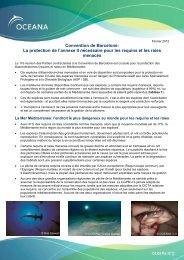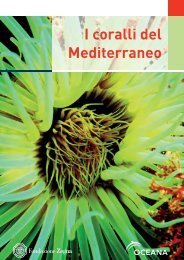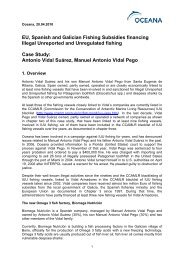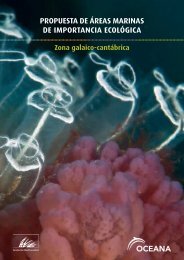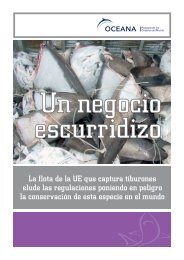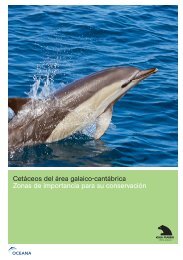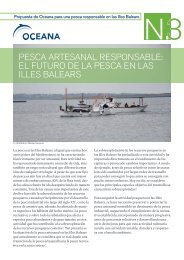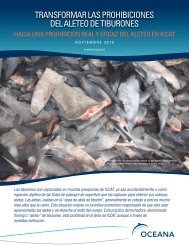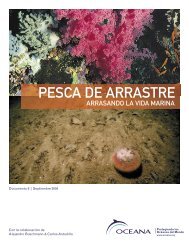Download - Oceana
Download - Oceana
Download - Oceana
Create successful ePaper yourself
Turn your PDF publications into a flip-book with our unique Google optimized e-Paper software.
SEAPEN AND BURROWING MEGAFAUNA<br />
OSPAR DEFINITION:<br />
According to the OSPAR background document “Case Report for the OSPAR List of threatened and/or<br />
declining species and habitats”, this habitat is define as plains of fine mud, at water depths ranging form<br />
15-200 m or more, which are heavily bioturbated by burrowing megafauna with burrows and mounds<br />
typically forming a prominent feature of the sediment surface.<br />
The habitat may include conspicuous populations of seapens, typically Virgularia mirabilis and Pennatula<br />
phosphorea. The burrowing crustaceans present may include Nephrops norvegicus, Calocaris<br />
macandreae or Callianassa subterranea. In the deeper fiordic lochs which are protected by entrance sill,<br />
the tall sepen Funiculina quadrangularis may also be present.<br />
The burrowing activity of megafauna creates a complex habitat, providing deep oxigen penetration.<br />
This habitat occurs extensively in sheltered basins of fjords, sea lochs, voes and in deeper offshores<br />
waters such as the northe Sea and Irish Sea basins.<br />
OSPAR Regions where the habitat occurs: I, II, III, IV<br />
OSPAR Regions where such habitat is under threat and/or decline: II, III<br />
Habitat occurs within each of the following deep seabed EUNIS types:<br />
A5.361. Seapens and burrowing megafauna in circalittoral fine mud.<br />
A5.362. Burrowing megafauna and [Maxmuelleria lankesteri] in circalittoral mud<br />
OCEANAS PROPOSALS:<br />
OCEANA has registered important areas dominated by this fauna in the II and IV regions of the OSPAR<br />
maritime area. The recorded areas occupy a range between 15 m to 450 m depth, depending on the<br />
species that predominates and its bathymetric distribution. All of them have been recorded on soft<br />
bottoms.<br />
Although the background document refers to this habitat in the northern area of the OSPAR maritime area,<br />
we would like to highlight the existence of this habitat in the southern area, both in Spanish and<br />
Portuguese waters.<br />
Apart from the species mentioned in that document, other Pennatulacea species such as Veretillum<br />
cynomorium and Kophobelemnon stelliferum have been recorded as predominant species in some areas<br />
in the IV OSPAR region.<br />
Due to technical restrictions, we can not give a relative density of the populations that make up this<br />
habitat, but we give some qualitative descriptions of the appearances of those types recorded by<br />
OCEANA in the OSPAR regions.<br />
Considering the necessity to define and describe the various habitats that must be considered as seapen<br />
and burrowing megafauna, OCEANA proposes the following:<br />
- Other species apart from those cited in the background document should be added.<br />
- New information about the distribution of habitat in the southern coutries should be considerer.<br />
69



